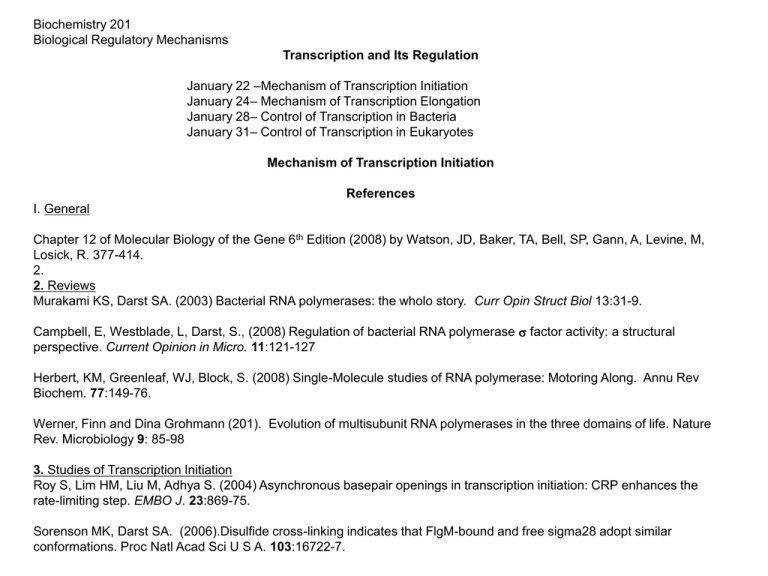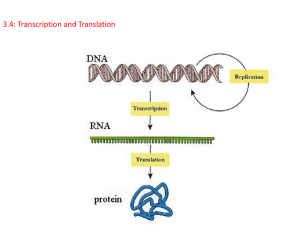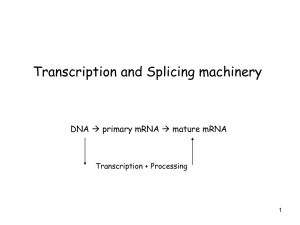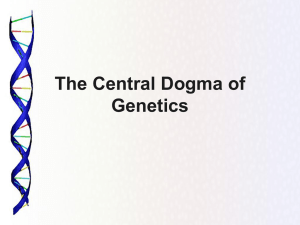Assay for RNA polymerase
advertisement

Biochemistry 201
Biological Regulatory Mechanisms
Transcription and Its Regulation
January 22 –Mechanism of Transcription Initiation
January 24– Mechanism of Transcription Elongation
January 28– Control of Transcription in Bacteria
January 31– Control of Transcription in Eukaryotes
Mechanism of Transcription Initiation
References
I. General
Chapter 12 of Molecular Biology of the Gene 6th Edition (2008) by Watson, JD, Baker, TA, Bell, SP, Gann, A, Levine, M,
Losick, R. 377-414.
2.
2. Reviews
Murakami KS, Darst SA. (2003) Bacterial RNA polymerases: the wholo story. Curr Opin Struct Biol 13:31-9.
Campbell, E, Westblade, L, Darst, S., (2008) Regulation of bacterial RNA polymerase factor activity: a structural
perspective. Current Opinion in Micro. 11:121-127
Herbert, KM, Greenleaf, WJ, Block, S. (2008) Single-Molecule studies of RNA polymerase: Motoring Along. Annu Rev
Biochem. 77:149-76.
Werner, Finn and Dina Grohmann (201). Evolution of multisubunit RNA polymerases in the three domains of life. Nature
Rev. Microbiology 9: 85-98
3. Studies of Transcription Initiation
Roy S, Lim HM, Liu M, Adhya S. (2004) Asynchronous basepair openings in transcription initiation: CRP enhances the
rate-limiting step. EMBO J. 23:869-75.
Sorenson MK, Darst SA. (2006).Disulfide cross-linking indicates that FlgM-bound and free sigma28 adopt similar
conformations. Proc Natl Acad Sci U S A. 103:16722-7.
Young BA, Gruber TM, Gross CA. (2004) Minimal machinery of RNA polymerase holoenzyme sufficient for
promoter melting. Science. 303:1382-1384
*Kapanidis, AN, Margeat, E, Ho, SO,.Ebright, RH. (2006) Initial transcription by RNA polymerase proceeds
through a DNA-scrunching mechanism. Science. 314:1144-1147.
Revyakin A, Liu C, Ebright RH, Strick TR (2006) Abortive initiation and productive initiation by RNA
polymerase involve DNA scrunching. Science. 314: 1139-43.
Murakami KS, Masuda S, Campbell EA, Muzzin O, Darst SA (2002). Structural basis of transcription
initiation: an RNA polymerase holoenzyme-DNA complex. Science. 296:1285-90.
Kostrewa D, Zeller ME, Armache KJ, Seizl M, Leike K, Thomm M, Cramer P.(2009) RNA polymerase II-TFIIB
structure and mechanism of transcription initiation. Nature. 462:323-30.
Discussion Paper
**Feklistov A and Darst, SA (2011) Structural basis for Promoter -10 Element recognition by the Bacterial
RNA Polymerase Subunit. Cell 147: 1257 – 1269
Accompanying preview: Liu X, Bushnell DA and Kornberg RD ( 2011) Lock and Key to Transcription:
–DNA Interaction. Cell: 147: 1218-1219
***Paul BJ, Barker MM, Ross W, Schneider DA, Webb C, Foster JW, Gourse RL. (2004) DksA: a critical
component of the transcription initiation machinery that potentiates the regulation of rRNA promoters by
ppGpp and the initiating NTP.
Cell. 6:311-22.
The accompanying minireview is helpful
Nickels, B.E. and Hochschild, A. (2004) Regulation of RNA Polymerase through the Secondary Channel. Cell
118:281-284
Key Points
1. Multisubunit RNA polymerases are conserved among all organisms
2. RNA polymerases cannot initiate transcription on their own. In bacteria 70 is required to initiate
transcription at most promoters. Among other functions, it recognizes the key features of most bacterial
promoters, the -10 and -35 sequences.
2. E. coli RNA polymerase holoenzyme, (core + ) finds promoter sequences by sliding along DNA and by
transfer from one DNA segment to another. This behavior greatly speeds up the search for specific DNA
sequences in the cell and probably applies to all sequence-specific DNA-binding proteins.
3. Transcription initiation proceeds through a series of structural changes in RNA polymerase, 70 and DNA.
4. A key intermediate in E. coli transcription initiation is the open complex, in which the RNA polymerase
holoenzyme is bound at the promoter and ~12 bp of DNA are unwound at the transcription startpoint. Open
complex formation does not require nucleoside triphosphates. Its presence can be monitored by a variety of
biochemical and structural techniques.
5. Recognition of the -10 element of the promoter DNA is coupled with strand separation
6. When the open complex is given NTPs, it begins the ‘abortive initiation’ phase, in which RNA chains of
5-10 nucleotides are continually synthesized and released.
7. Through a “DNA scrunching” mechanism the energy captured during synthesis of one of these short
transcripts eventually breaks the enzyme loose from its tight connection to the promoter DNA, and it begins
the elongation phase.
7. Aspects of the mechanism of initiation are likely to be conserved in eukaryotic RNA polymerase
Transcription is Important
transcription
(RNA processing)
rRNAs
mRNAs
translation
proteins
snRNAs
Other non-coding RNAs
(e.g. telomerase RNA)
miRNAs
Transcription/Splicing/Translation Provide
A Large Range of Protein Concentrations
I. RNA polymerases
Subunits of RNAP
Cellular RNA polymerases in all living organisms are evolutionary
related
LUCA-Last universal common ancestor
a common structural and functional frame work
of transcription in the three domains of life
Structure of RNAP in the three domains
Universally conserved
Archaeal/eukaryotic
Bacteria
Archaea
Eukarya
Transcription
Werner and Grohmann (2011),
Nature Rev Micro 9:85-98
Extra RNAP subunits provide interaction sites for transcription
factors, DNA and RNA, and modulate diverse RNAP activities
Evolutionary relationships of general transcription factors
Initiation
Transcript cleavage
Gre
Elongation
LUCA may have had elongating, not initiating RNA polymerase
II. Challenges in initiating transcription
1. RNAP is specialized to ELONGATE, not INITIATE
2. Initiating RNAP must open DNA to permit transcription
3. RNAP must leave promoter—abortive initiation
The Initiating Form of RNA Polymerase
(1) The discovery of initiation factors
factor is required for bacterial RNA polymerase to
initiate transcription on promoters
'
'
+
KD ~ 10-9 M
}
‘core’
}
‘holoenzyme’
Can begin transcription
on promoters and can
elongate
Can elongate but cannot
begin transcription at
promoters
How was discovered (Burgess, 1969)
A. Assay for RNA polymerase:
E.coli lysate
*ATP
CTP
GTP
UTP
Calf thymus DNA
buffer
Look for incorporation of *ATP into RNA chains
B. Initial purification
Lysate
various fractionation steps
(DEAE column, glycerol gradient etc)
Active fractions identified by assay
C. Improved purification of RNA polymerase:
lysate
Improved fractionation
phosphocellulose column
1
Fraction #
SDS gel analysis
Peak 1
Peak 2
'
Peak 1 restored activity
increases rate of initiation
Transcription
DNA
2
Activity (*ATP)
CT DNA
OD 280
salt
Labmate Jeff Roberts
reported that the new,
improved preparation of
RNAP (peak 2) had no
activity on DNA
Assay:
incorporation P ATP
g
(2) Bacterial promoters
There are several flavors of promoters
and recruit RNAP to promoter DNA
(3) undergoes a large conformational change upon binding
to RNA polymerase
Free doesn’t bind DNA
Sorenson; 2006
in holoenzyme positioned for DNA recognition
is positioned for DNA recognition
is positioned to affect key activities of RNA polymerase
Surprising structural similarity between the initiating forms
of bacterial and eukaryotic RNAP
The first two steps of Eukaryotic transcription
In archae, TBP and TFB are sufficient for formation of the preinitiation complex (PIC), suggesting that they are key to the mechanism
of transcription initiation in eukaryotes
TFB
TBP
Promoter
Many archae have a proliferation of TBPs and TFBs, suggesting that
they provide choice in promoters, akin to alternative s.
TFIIB has a central role in initiation similar to that of
TFIIB structure
Recruits Pol II to promoter: N-terminus binds
Pol II; C terminus binds TBP and DNA
Role in promoter opening; B linker mutants recruit PolII
but cant strand open or initiate
Role in selection of TSS ( Inr): B reader mutants
Blocks elongating RNA chain: B reader
Crystal structure of TFB + RNA polymerase--archae
D Kostrewa et al. Nature 462, 323-330 (2009) doi:10.1038/nature08548
Topological similarities in /TFIIB binding to RNAP
B ribbon (4):both bind flap tip helix
B linker (2): both bind coiled -coil and rudder; both
B core (3)
involved in strand opening
B reader ( 3.2): both in exit channel and near
active site; start site selection
D Kostrewa et al. Nature 462, 323-330 (2009) doi:10.1038/nature08548
TFIIB and bound to RNA polymerase show surprising similarity.
Analogously placed regions have similar functions
Initiating RNAP must open DNA to permit transcription:
Formation of the open complex
Steps in transcription initiation
NTPs
KB
R+P
RPc
initial
binding
Kf
RPo
“isomerization”
Abortive
Initiation
Elongating
Complex
A detailed look at a prokaryotic promoter
Frequency of nucleotides at
each position (%)
100
G
A
T
75
C
50
25
0
T
T
G
A
C
-5
A
15-19
nucleotides
T
A
T
A
A
-1
Sequence Logos
-35 logo
-10 logo
T
Recognition of the prokaryotic promoter
-35 logo
-10 logo
Helix-turn-helix in Domain 4
Recognizes -35 as duplex DNA
Is the -10 promoter element recognized as Duplex or SS DNA?
Approach
1. Determine a high resolution structure of 2 bound to non-template strand of the -10 element
Schematic
2. Determine whether this structure represents the “initial binding state” or endpoint state
Promoter escape
is positioned to affect key activities of RNA polymerase
Promoter escape and Abortive Initiation
during abortive initiation, RNAP synthesizes many
short transcripts, but reinitiates rapidly. How can
the active site of RNAP move forward along the DNA
while maintaining promoter contact?
Using single molecule FRET to monitor movement of RNAP and DNA
Förster (fluorescence) resonance energy transfer (FRET) allows the determination of intramolecular distances through fluorescent
coupling between a donor (yellow star) and an acceptor (red star) dye. When the donor (yellow star) is excited (blue arrows) it emits
light. When the donor fluorophore moves sufficiently close to the acceptor (right), resonance energy transfer results in emission of a
longer wavelength by the acceptor. The degree of acceptor emission relative to donor excitation is sensitive to the distance between
the attached dyes.This process depends on the inverse sixth power of the distance between fluorophores. By measuring the intensity
change in acceptor fluorescence, distances on the order of nanometers can currently be measured in single molecules with
millisecond time resolution
Experimental set-up for single molecule FRET: Single transcription complexes labeled
with a fluorescent donor (D, green) and a fluorescent acceptor (A, red) are illuminated as
they diffuse through a femtoliter-scale observation volume (green oval; transit time ~1
ms); observed in confocal microscope
Three models for Abortive initiation
#1
Predicts movement of both the RNAP leading and trailing edge relative to DNA
#2
Predicts expansion and contraction of RNAP
#3
Predicts expansion and contraction of DNA
Initial transcription involves DNA scrunching
Open complex
Lower E* peak is free DNA; higher E* peak is DNA in open complex;
distance is shorter because RNAP induces DNA bending
A. N. Kapanidis et al., Science 314, 1144 -1147 (2006)
Initial transcription involves DNA scrunching
Open complex
Abortive initiation complex
Higher E* in Abortive initiation complex than open complex
results from DNA scrunching
Initial transcription involves DNA scrunching
Open complex
Abortive initiation complex
The energy accumulated in the DNA scrunched “stressed
intermediate could disrupt interactions between RNAP, and
the promoter, thereby driving the transition from initiation to
elongation
At a typical promoter, promoter escape occurs only after synthesis of an RNA product ~9 to 11 nt in length (1–11) and thus can be
inferred to require scrunching of ~7 to 9 bp (N – 2, where N = ~9 to 11; Fig. 3C). Assuming an energetic cost of base-pair breakage of
~2 kcal/mol per bp (30), it can be inferred that, at a typical promoter, a total of ~14 to 18 kcal/mol of base-pair–breakage energy is
accumulated in the stressed intermediate. This free energy is high relative to the free energies for RNAP-promoter interaction [~7 to
9 kcal/mol for sequence-specific component of RNAP-promoter interaction (1)] and RNAP-initiation-factor interaction [~13 kcal/mol
for transcription initiation factor {sigma}70 (31)].
Validation of the prediction that occlusion of the RNA exit
channel promotes “abortive initiation”
#1: transcription by holoenzyme with full-length
#2: transcription by holoenzyme with truncated at Region 3.2: lacks in
the RNA exit channel
Murakami, Darst 2002
is positioned to affect key activities of RNA polymerase








